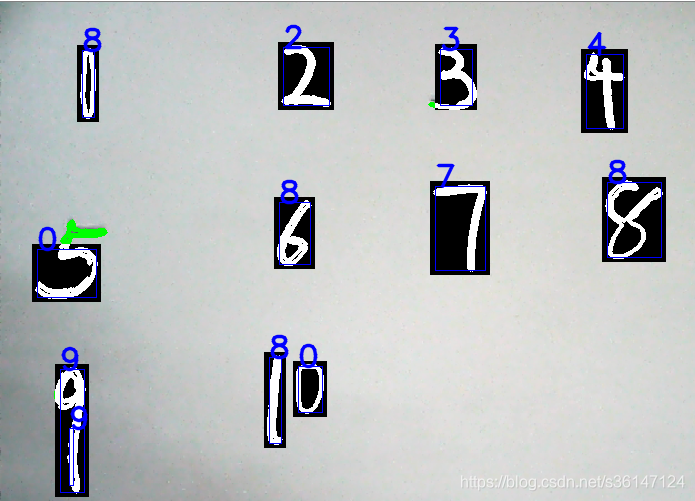学习笔记:python+CNN识别手写数字(自己的数据集)2.0
2020-01-13 23:38
393 查看
由1.0升级的这个2.0其实也非常的简单,无非是按照1.0预处理那样的方式,处理好图片,准确率确实提高了
1.数据集
我是做成黑底白字的图片放在data文件夹里
命名格式是0_,1_这种,_前代表label,图片来源于网上

2.训练,细心的朋友可以发现我省略了验证集的部分
import os
os.environ['TF_CPP_MIN_LOG_LEVEL']='2'
import tensorflow as tf
old_v = tf.compat.v1.logging.get_verbosity()
tf.compat.v1.logging.set_verbosity(old_v)
tf.compat.v1.logging.set_verbosity(tf.compat.v1.logging.ERROR)
import tensorflow.examples.tutorials.mnist.input_data as input_data
from PIL import Image
import numpy as np
import random
import cv2
data_dir="data"
MODEL_SAVE_PATH = "model_data/"
MODEL_NAME = "save_net.ckpt"
def weight_variable(shape):
initial = tf.truncated_normal(shape, stddev=0.1)
return tf.Variable(initial)
def bias_variable(shape):
initial = tf.constant(0.1, shape=shape)
return tf.Variable(initial)
def conv2d(x, W):
return tf.nn.conv2d(x, W, strides=[1, 1, 1, 1], padding="SAME")
def max_pool_2x2(x):
return tf.nn.max_pool(x, ksize=[1, 2, 2, 1], strides=[1, 2, 2, 1], padding='SAME')
def read_data(data_dir):
datas = []
labes = []
fnames = []
for fname in os.listdir(data_dir):
fpath = os.path.join(data_dir, fname)
fnames.append(fname)
image = Image.open(fpath)
data = np.array(image) /255.0
data=cv2.resize(data,(28,28),interpolation=cv2.INTER_AREA)
label = int(fname.split("_",1)[0])
datas.append(data)
labes.append(label)
datas = np.array(datas)
datas = np.reshape(datas, (-1, 784))
labels=np.zeros((200,10))
for i in range(0, 200):
m = labes[i]
labels[i][m] = 1
print("shape of datas: {}\tshape of labels: {}".format(datas.shape,labels.shape))
return fnames, datas, labels
fnames, datas, labels = read_data(data_dir)
x = tf.placeholder(tf.float32, [None, 784])
w_conv1 = weight_variable([5, 5, 1, 32])
b_conv1 = bias_variable([32])
x_image = tf.reshape(x, [-1, 28, 28, 1])
y_ = tf.placeholder("float", [None, 10])
h_conv1 = tf.nn.relu(conv2d(x_image, w_conv1) + b_conv1)
h_pool1 = max_pool_2x2(h_conv1)
w_conv2 = weight_variable([5, 5, 32, 64])
b_conv2 = bias_variable([64])
h_conv2 = tf.nn.relu(conv2d(h_pool1, w_conv2) + b_conv2)
h_pool2 = max_pool_2x2(h_conv2)
w_fc1 = weight_variable([7 * 7 * 64, 1024])
b_fc1 = bias_variable([1024])
h_pool2_flat = tf.reshape(h_pool2, [-1, 7 * 7 * 64])
h_fc1 = tf.nn.relu(tf.matmul(h_pool2_flat, w_fc1) + b_fc1)
keep_prob = tf.placeholder("float")
h_fc1_drop = tf.nn.dropout(h_fc1, keep_prob)
w_fc2 = weight_variable([1024, 10])
b_fc2 = bias_variable([10])
y_conv = tf.nn.softmax(tf.matmul(h_fc1_drop, w_fc2) + b_fc2)
cross_entropy = -tf.reduce_sum(y_ * tf.log(y_conv))
train_step = tf.train.AdamOptimizer(1e-4).minimize(cross_entropy)
correct_prediction = tf.equal(tf.argmax(y_conv, 1), tf.argmax(y_, 1))
accuracy = tf.reduce_mean(tf.cast(correct_prediction, "float"))
saver = tf.train.Saver()
with tf.Session() as sess:
sess.run(tf.global_variables_initializer())
for i in range(4000):
batchdata = []
batchlabel = []
for j in range(0, 50):
a = random.randint(0, 199)
batchdata.append(datas[a])
batchlabel.append(labels[a])
batchdata = np.array(batchdata)
batchlabel = np.array(batchlabel)
if i % 100 == 0:
train_accuracy = accuracy.eval(feed_dict={x: batchdata, y_: batchlabel, keep_prob: 1})
print("step %d,training accuracy %g" % (i, train_accuracy))
train_step.run(feed_dict={x: batchdata, y_: batchlabel, keep_prob: 0.5})
print("test accuracy %g" % accuracy.eval(feed_dict={x: datas, y_: labels, keep_prob: 0.5}))
3.测试效果,和1.0相比没变化
import os
os.environ['TF_CPP_MIN_LOG_LEVEL']='2'
import tensorflow as tf
old_v = tf.compat.v1.logging.get_verbosity()
tf.compat.v1.logging.set_verbosity(old_v)
tf.compat.v1.logging.set_verbosity(tf.compat.v1.logging.ERROR)
import numpy as np
import imutils
import cv2
def weight_variable(shape):
initial = tf.truncated_normal(shape,stddev = 0.1)
return tf.Variable(initial)
def bias_variable(shape):
initial = tf.constant(0.1,shape = shape)
return tf.Variable(initial)
def conv2d(x,W):
return tf.nn.conv2d(x, W, strides = [1,1,1,1], padding = 'SAME')
def max_pool_2x2(x):
return tf.nn.max_pool(x, ksize=[1,2,2,1], strides=[1,2,2,1], padding='SAME')
im=cv2.imread('yuanshi.png')
im=imutils.resize(im,height=500)
gray=cv2.cvtColor(im,cv2.COLOR_BGR2GRAY)
imgG=cv2.GaussianBlur(gray,(5,5),0)
erosion=cv2.erode(imgG,(3,3),iterations=3)
dilate=cv2.dilate(erosion,(3,3),iterations=3)
edged=cv2.Canny(dilate,80,200,255)
aa,contours, hierarchy=cv2.findContours(edged,cv2.RETR_EXTERNAL, cv2.CHAIN_APPROX_SIMPLE)
cv2.drawContours(im,contours,-1,(0,255,0),3)
digitcnts=[]
for i in contours:
(x,y,w,h)=cv2.boundingRect(i)
if w <100 and h > 45 and h <160:
digitcnts.append(i)
m = 0
for c in digitcnts:
(x, y, w, h) = cv2.boundingRect(c)
m += 1
roi = im[y-5:y + h+5, x-5:x + w+5]
height, width, channel = roi.shape
for i in range(height):
for j in range(width):
b, g, r = roi[i, j]
if g > 250:
b = 255
r = 255
g = 255
else:
b = 0
g = 0
r = 0
roi[i, j] = [r, g, b]
cv2.imwrite('%d.png' % m, roi)
x = tf.placeholder(tf.float32, [None, 784])
y_ = tf.placeholder(tf.float32, [None, 10])
W_conv1 = weight_variable([5, 5, 1, 32])
b_conv1 = bias_variable([32])
x_image = tf.reshape(x,[-1,28,28,1])
h_conv1 = tf.nn.relu(conv2d(x_image,W_conv1) + b_conv1)
h_pool1 = max_pool_2x2(h_conv1)
W_conv2 = weight_variable([5, 5, 32, 64])
b_conv2 = bias_variable([64])
h_conv2 = tf.nn.relu(conv2d(h_pool1, W_conv2) + b_conv2)
h_pool2 = max_pool_2x2(h_conv2)
W_fc1 = weight_variable([7 * 7 * 64, 1024])
b_fc1 = bias_variable([1024])
h_pool2_flat = tf.reshape(h_pool2, [-1, 7*7*64])
h_fc1 = tf.nn.relu(tf.matmul(h_pool2_flat, W_fc1) + b_fc1)
keep_prob = tf.placeholder("float")
h_fc1_drop = tf.nn.dropout(h_fc1, keep_prob)
W_fc2 = weight_variable([1024, 10])
b_fc2 = bias_variable([10])
y_conv=tf.nn.softmax(tf.matmul(h_fc1_drop, W_fc2) + b_fc2)
cross_entropy = -tf.reduce_sum(y_*tf.log(y_conv))
train_step = tf.train.AdamOptimizer(1e-4).minimize(cross_entropy)
correct_prediction = tf.equal(tf.argmax(y_conv,1), tf.argmax(y_,1))
accuracy = tf.reduce_mean(tf.cast(correct_prediction, "float"))
saver = tf.train.Saver()
with tf.Session() as sess:
sess.run(tf.global_variables_initializer())
saver.restore(sess, "model_data/save_net.ckpt") # 使用模型,参数和之前的代码保持一致
outputlist=[]
k=0
for c in digitcnts:
k=k+1
img = cv2.imread('%d.png' % k)
img = cv2.resize(img, (28, 28), interpolation=cv2.INTER_CUBIC)
gray = (cv2.cvtColor(img, cv2.COLOR_BGR2GRAY)) / 255
img = np.reshape(gray, [-1, 784])
prediction = tf.argmax(y_conv, 1)
predint=prediction.eval(feed_dict={x: img,keep_prob: 1.0}, session=sess)
print('the predict is : ', predint[0])
outputlist.append(predint[0])
p = 0
for c in digitcnts:
(x, y, w, h) = cv2.boundingRect(c)
d=outputlist
p= p+1
font = cv2.FONT_HERSHEY_SIMPLEX
cv2.rectangle(im, (x, y), (x + w, y + h), (255, 0, 0), 0)
cv2.putText(im,str(d),(x,y),font,1,(255,0,0),2,cv2.LINE_AA)
cv2.imshow('img', im)
cv2.waitKey(0)
cv2.destroyAllWindows()
[p]

其实可以发现,对于书写清楚,筛选范围内数字准确率祥比mnist数据集提高了两成吧,比较我的数据集只有200个图片
- 点赞
- 收藏
- 分享
- 文章举报
 该死的碳酸饮料呀
发布了18 篇原创文章 · 获赞 0 · 访问量 177
私信
关注
该死的碳酸饮料呀
发布了18 篇原创文章 · 获赞 0 · 访问量 177
私信
关注
相关文章推荐
- 【CNTK】CNTK学习笔记之制作自己的数据集(以MNIST手写数字数据集为例)
- Python 学习笔记(Machine Learning In Action)K-近邻算法识别手写数字
- 手写数字识别-(卷积神经网络)-基于keras的python学习笔记(十一)
- Python scikit-learn 学习笔记—手写数字识别
- caffe学习笔记——python+mnist手写数字识别
- caffe的python接口学习(4):mnist实例---手写数字识别
- TensorFlow学习-基于CNN实现手写数字识别
- 5/12 cnn 手写字体识别代码学习笔记
- [Python]基于CNN的MNIST手写数字识别
- 学习笔记TF024:TensorFlow实现Softmax Regression(回归)识别手写数字
- Caffe——Python接口学习(4):mnist实例——手写数字识别
- 深度学习笔记(四)用Torch实现MNIST手写数字识别
- 【深度学习】笔记2_caffe自带的第一个例子,Mnist手写数字识别代码,过程,网络详解
- TensorFlow学习_02_CNN卷积神经网络_Mnist手写数字识别
- 深度学习框架Caffe学习笔记(2)-MNIST手写数字识别例程
- Tensorflow深度学习之八:再探CNN解决mnist手写数字识别问题
- 学习笔记(五)Tensorflow实现Soft Regression简单识别MNIST手写数字
- Keras_深度学习_MNIST数据集手写数字识别之各种调参
- DL之LiR&DNN&CNN:利用LiR、DNN、CNN算法对MNIST手写数字图片(csv)识别数据集实现(10)分类预测
- 深度学习笔记(一):mnist 数据集手写数字图片识别
